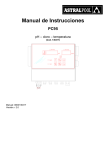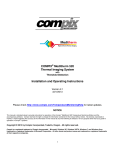Download Manual de Instrucciones
Transcript
Manual de Instrucciones PC 2000 pH – redox – temperatura Manual: Versión: 1.0 Índice: 1___DATOS TÉCNICOS pág. 3 2___CONEXIONES EN LA BORNERA pág. 4 3___PANEL DE MANDOS 3.1___DESCRIPCIÓN GENERAL DEL TECLADO pág. 5 3.2___DESCRIPCIÓN GENERAL DE LOS INDICADORES LUMINOSOS pág. 6 4___ENCENDIDO Y CONFIGURACIONES PRELIMINARES pág. 7 5___CALIBRACIÓN INSTRUMENTO pág. 8 5.1___CALIBRACIÓN SONDA pH 5.3___CALIBRACIÓN SONDA REDOX 5.3___VERIFICACIÓN SONDAS pág. 9 pág. 11 pág. 12 6___MENÚ PROGRAMACIÓN pág. 14 6.1___LISTA DE LAS VARIABLES MENÚ MÍNIMO (255) 6.1___LISTA DE LAS VARIABLES MENÚ COMPLETO (25) pág. 15 pág. 15 7___REGULACIONES pág. 16 7.1___ON / OFF pág. 16 7.2___PROPORCIONAL EN EL TIEMPO pág. 16 7,3___PROTECCIÓN PARÁMETROS pág. 16 7.4___ REGULACIÓN PROPORCIONAL EN CORRIENTE pág. 16 7.5___ FUNCIÓN SET POINT pág. 17 7.6___ REGULACIÓN MANUAL Y CEBADO BOMBAS pág. 17 7.7___ ALARMA FLUJO pág. 17 7.8___ PROTECCIÓN DE LA PROGRAMACIÓN pág. 17 8___MEMO DE PROGRAMACIÓN pág. 18 1___DATOS TÉCNICOS MEDIDAS: GRADO DE PROTECCIÓN: SECCIÓN DE LOS BORNES: 240 mm – 245 mm – 140 mm IP65 (salvo BNC) 4mm2 , o diámetro 2,4 mm ALIMENTACIÓN: CONSUMO: CAPACIDAD MÁXIMA EN RELÉS: standard 230V ± 10% 50-60 Hz. Bajo pedido 115V 7W + 9W electroválvula 3A (con carga resistiva) 250 Vac 0…50 ° C TEMPERATURA DE TRABAJO TEMPERATURA DE ALMACENAJE ESCALA DE MEDIDA DEL pH: PRECISIÓN DE LA MEDIDA: IMPEDANCIA DE ENTRADA: COMPENSACIÓN EN TEMPERATURA: AJUSTE DEL SET POINT: REPETICIÓN REMOTA MEDIDA: ESCALA DE MEDIDA DEL Redox: PRECISIÓN DE LA MEDIDA: AJUSTE DEL SET POINT: SALIDA RETRANSMITIDA: -10…+70 °C 0…14,00 ± 0,1 pH > 1013 ohm MANUAL/AUTOMÁTICA 0…125 °C ON / OFF PAUSA / TRABAJO PROPORCIONAL EN CORRIENTE: 0/4…20 mA separada galvánicamente Configurable para transmisión medida o regulación Resolución 255 puntos Carga máxima 1 K ohm 0…999 mV ± 1 mv ON / OFF PAUSA / TRABAJO PROPORCIONAL EN CORRIENTE: 0/4…20 mA separada galvánicamente Configurable para transmisión medida o regulación Carga máxima 1 K ohm 2___CONEXIONES EN LA BORNERA N° Borne Descripción 1 2 3 4–5 6–7 8–9 10 – 11 12 – 14 13 – 14 15 16 17 18 19 20 21 22 23 24 25 26 27 TIERRA FASE NEUTRO RELÉ BOMBA PH RELÉ BOMBA CLORO RELE ALARMA RELÉ E.V. INPUT SEÑAL KEY INPUT SEÑAL FLUS NO UTILIZADO NO UTILIZADO INPUT PT100 INPUT PT100 INPUT PT100 OUTPUT FREC. PROP. PH POLO NEG. OUTPUT FREC. PROP. PH POLO POS. OUTPUT FREC. PROP. CL POLO NEG. OUTPUT FREC. PROP. CL POLO POS. OUTPUT CORR. PROP. PH POLO POS. OUTPUT CORR. PROP. PH POLO NEG. OUTPUT CORR. PROP. CL POLO POS. OUTPUT CORR. PROP. PH POLO NEG. pH mV NOTA: HACIENDO UN PUENTE ENTRE LOS BORNES 17 Y 19 EL INSTRUMENTO RECONOCE QUE LA SONDA DE TEMPERATURA ESTÁ DESCONECTADA Y HACE REFERENCIA A LA REGULACIÓN MANUAL. 3___PANEL DE MANDOS 3.1 5 6 DESCRIPCIÓN GENERAL DEL TECLADO Visualiza en secuencia los set point configurados, si la función está habilitada permite cambiar su valor. Utilizado al mismo tiempo con la tecla ACK permite forzar el estado de los relés de set. Presionando la tecla aparece el mensaje ProG, manteniendo pulsada la tecla durante 5 segundos se entra en programación. Si la tecla está inhabilitada por la protección efectuada en la bornera, presionándola aparece el mensaje dIS. Cuando se entra en programación, cada vez que se presiona esta tecla se avanza un paso (step). Hace retroceder los pasos de programación. Si se mantiene presionada durante 5 segundos sale de la función de programación, guarda todos los datos en la memoria permanente. Apagar el relé de alarma, pero si el estado de alarma persiste, el LED correspondiente pasa de intermitente a fijo y queda encendido hasta que se elimina la causa de la alarma. Elimina un mensaje de error y restablece el valor de defecto del dato errado Aumenta el valor visualizado en la fase de programación. Aumenta el valor visualizado con la tecla SET. Visualiza la temperatura de referencia (manual o automática). Si la temperatura es manual, presionar al mismo tiempo con la tecla DOWN para su modificación. Permite modificar el valor de temperatura. Reduce el valor visualizado en la fase de programación. Reduce el valor visualizado con la tecla SET. Habilita la función manual, si se presiona al mismo tiempo con la tecla SET permite forzar en manual los relés de comando de las bombas. Permite entrar en el Menú de calibración. 3.2 DESCRIPCIÓN GENERAL DE LOS INDICADORES LUMINOSOS Display de la medida pH Display de la medida Redox Diodo LED bicolor. Indica el estado de la bomba pH APAGADO VERDE ROJO ROJO INTERMITENTE La bomba del pH está apagada El set point está activo pero la bomba está temporalmente apagada El set point está activo y la bomba está funcionando En la fase de programación indica que el parámetro visualizado se refiere al control del set point pH. Diodo LED bicolor. Indica el estado de la bomba cloro APAGADO VERDE ROJO ROJO INTERMITENTE La bomba del cloro está apagada El set point está activo pero la bomba está temporalmente apagada El set point está activo y la bomba está funcionando En la fase de programación indica que el parámetro visualizado se refiere al control del set point del Redox. Diodo LED Rojo. Indica un estado de ALARMA. ROJO INTERMITENTE ROJO Se ha producido un estado de alarma; el relé alarma está activo, para apagar la alarma presionar la tecla ACK. Se ha reconocido una alarma con la tecla ACK pero la causa que la había generado aún persiste, eliminando la causa el LED Alarm se apaga. Diodo LED Rojo. Indica un estado de parada total de las funciones del instrumento. ROJO Cuando está encendido señala el bloque temporal del funcionamiento de las bombas, las salidas en corriente quedan bloqueadas en el último valor retransmitido. FUNCIONES DE CALIBRACIÓN 7 pH 4 pH 465 mv El instrumento pide que el electrodo sea sumergido en solución patrón 7 pH; por tanto está listo para efectuar calibración del offset para el electrodo pH. El instrumento pide que el electrodo sea sumergido en solución patrón 4 pH; por tanto está listo para efectuar calibración de la ganancia para el electrodo pH. una una una una El instrumento pide que el electrodo sea sumergido en una solución patrón 465 mV; así está listo para efectuar una calibración de la ganancia para el electrodo Redox. UNIDAD DE MEDIDA °C % SEC. mA El valor numérico visualizado es una temperatura expresada en °C Si este indicador está encendido al mismo tiempo que el led %, significa que el valor numérico visualizado es un coeficiente de corrección según temperatura expresado en %/°C. El valor numérico visualizado es un porcentaje El valor numérico visualizado es una unidad de tiempo expresada en segundos El valor numérico visualizado es un valor de corriente de salida expresado en mA o es un parámetro de programación que actúa sobre una salida en corriente. 4___ENCENDIDO Y CONFIGURACIONES PRELIMINARES El instrumento muestra, al encenderlo, el mensaje Redo r 1.2 que indica el nombre y la versión del software que ha sido cargada. El instrumento visualiza el mensaje HOLD --- Después de un tiempo de aproximadamente 10 segundos de espera, en el cual el instrumento ejecuta un test de software, el instrumento visualiza la medida del pH y del Redox, está claro que estos valores no son verdaderos ya que no ha sido efectuada la calibración de las sondas. ¡Atención! Apagar las bombas antes de encender el instrumento ya que podría causar una dosificación errónea debido al error de medida recién mencionado. Abrir el flujo del agua en el panel y configurar, con el caudalímetro, un caudal de 60 litros/hora para garantizar un buen flujo de agua para las sondas. Ajustar los valores pH = 7.20 pH y redox = 700 mV (aproximadamente) manualmente y hacer circular el agua en el panel durante aproximadamente 2 horas para adaptación sonda ph y redox. En las explicaciones siguientes de los menús y de las funciones del instrumento se utilizará este símbolo para indicar las teclas a presionar. 5___CALIBRACIÓN Para entrar en el menú Calibración mantener pulsada la tecla durante 5 segundos, el instrumento presenta el mensaje Hold Cal; después de dicho tiempo aparece el mensaje PH CAL con el LED Hold encendido. Utilizando la tecla seguirán cíclicamente las palabras PH, ORP, CRT. 5.1___CALIBRACIÓN SONDA pH El electrodo de pH debe ser recalibrado periódicamente hasta que, debido a su excesivo agotamiento, es preciso cambiarlo. La operación de calibración del electrodo es controlada de manera semiautomática por el instrumento PC 2000, que reconoce de manera autónoma el valor de norma de la solución patrón en la cual está sumergido el electrodo y que visualiza un parámetro de calidad para indicar el grado de agotamiento de la sonda. Material necesario para la calibración: 1) 2) 3) Solución tampón 7 pH bien conservada (FRASCO N° 1) Solución tampón 4 ó 9.22 pH bien conservada (FRASCO N° 3) Agua limpia para lavar el electrodo (FRASCO N° 2) NOTAS: Una solución con 4 pH es siempre preferible a una solución con 9 ó 10 pH, se trata de un valor de pH mucho más estable en el tiempo y sobre el cual no influye la temperatura. Durante la fase de calibración se debe evitar introducir el electrodo en las soluciones tampón sin primero lavarlo cuidadosamente. No secar el electrodo frotándolo con papel o trapos sino dejarlo escurrir naturalmente. Las soluciones tampón se deben guardar siempre en un sitio oscuro y fresco, se debe evitar el uso de soluciones por más de un año. PROCESO Cerrar el flujo del agua. 1. Entrar en el menú calibración (ver pág 8) y seleccionar la función PH CAL 2. Confirmar con la tecla calibración de la sonda pH. 3. Ahora aparece el mensaje CAL intermitente PH con el led 7 pH intermitente. 4. Extraer el electrodo de pH del portasondas. 5. Lavar el electrodo en el frasco n° 2 que contiene agua limpia. 6. Sumergir el electrodo en el frasco n° 1 con la solución 7 pH durante 15 segundos. 7. Presionar la tecla 8. En el display aparece el mensaje 7.00 si reconoce la solución tampón. (En caso de error cambiar la solución tampón) para proceder con una 9. Presionar la tecla es reconocida. el valor de la solución tampón 10. Presionar la tecla en el display aparece el mensaje OFFS PH. Esperar 30 segundos para la calibración de la sonda. El instrumento calcula el valor de OFFSET y visualiza la calidad del electrodo en porcentaje. 11. Al cabo de 5 segundos en el display aparece el mensaje CAL PH y el led 4 pH intermitente 12. Lavar el electrodo en el frasco n° 2 que contiene agua limpia. 13. Sumergir el electrodo en el frasco n° 3 con la solución 4 pH durante 15 segundos. 14. Presionar la tecla 15. En el display aparece el valor de la solución tampón reconocida. (En caso de error cambiar la solución tampón) 16. Si se utiliza una diferente se debe corregir el valor de la solución tampón con las teclas 17. Presionar la tecla . En el display aparece el mensaje GAIN PH. Esperar 30 segundos. El instrumento calcula el valor de GAIN y visualiza la calidad del electrodo en porcentaje. 18. El instrumento guarda los parámetros calculados y visualiza durante un segundo en el display SAVE PAR. Sale del menú calibración y regresa al estado de medida, resta activo el estado de HOLD. 19. Poner de nuevo el electrodo en el portasondas y abrir de nuevo el flujo del agua ajustándolo en 60 litros/hora, presionar la tecla para eliminar el estado de HOLD. 5.2___CALIBRACIÓN SONDA REDOX Cerrar el flujo del agua. Entrar en el menú calibración (ver pág 8) y seleccionar la función ORP CAL Confirmar con la tecla calibración de la sonda redox. para proceder con una Ahora aparece el mensaje CAL intermitente MV con el led 465 mV intermitente. Extraer el electrodo de pH del portasondas. Lavar el electrodo en el frasco n° 2 que contiene agua limpia. Sumergir el electrodo en el frasco con la solución 465 mV por un tiempo de 15 segundos. Presionar la tecla En el display aparece el mensaje 465 si reconoce la solución Tampón. (En caso de error cambiar la solución tampón) Presionar la tecla el valor de la solución tampón es reconocida. Presionar la tecla , en el display aparece el mensaje OFFS MV. Esperar 30 segundos para la calibración de la sonda. El instrumento calcula el valor de OFFSET y visualiza la calidad del electrodo en porcentaje. En el display aparece CAL END En el display aparece 0 THL. Es posible configurar con las teclas un tiempo de HOLD (expresado en segundos) para consentir a las sondas que se adapten al circuito. El instrumento queda en estado de HOLD por el tiempo configurado. 5.3___VERIFICACIÓN SONDAS Una vez terminados los procesos de calibración es posible leer los valores en porcentaje de la calidad de las sondas calibradas. Entrar en el menú calibración (ver pág 8) y seleccionar la función Ctr CAL. En el display aparece el mensaje Ctr CAL con los led 7pH, 4pH, CL2 intermitentes. Presionar la tecla En el display aparece o100 Ctr con el led 7 pH y % encendido, el instrumento indica la calidad OFFSET del electrodo pH. Presionar la tecla En el display aparece G100 Ctr con el led 4 pH y % encendido, el instrumento indica la calidad GAIN del electrodo pH. Presionar la tecla En el display aparece o100 Ctr con el led Cl2 y % encendido, el instrumento indica la calidad OFFSET del electrodo Redox. Presionar la tecla En el display aparece G100 Ctr con el led Cl2 y % encendido, el instrumento indica la calidad GAIN del electrodo Redox. Para salir del menú presionar la tecla Las indicaciones de calidad del electrodo se deben considerar por separado, un grado bajo de calidad en una de las dos, indica escasa calidad aunque la otra indicación sea buena. ATENCIÓN: Verificar siempre la calidad de las soluciones de muestra, deben ser nuevas, de color homogéneo y no deben formarse algas dentro. EJEMPLO: Supongamos que en la calibración con 7 pH la calidad resulte ser del 10%, mientras que en la calibración con 4 pH la calidad resulte ser del 98%. En tal caso es evidente que el elemento de referencia del electrodo se ha estropeado precozmente. Este fenómeno por ejemplo es típico en las instalaciones de cloración en que se efectúan cloraciones SHOCK que tienden a contaminar la referencia del electrodo. En este caso sería una buena solución cerrar el sistema de medida en la fase de supercloración o utilizar los electrodos previstos de doble barrera, expresamente construidos para no ser perjudicados por el cloro disuelto en el agua. 6___MENÚ PROGRAMACIÓN Para acceder al menú programación mantener presionada la tecla el display aparece PROG durante 5 segundos. En Entra en la función de programación, es visualizada la palabra 0 PAS, con las teclas configurar el número de contraseña. Presionando la tecla con la palabra 255 PAS se accede al menú mínimo que se compone de las variables indispensables. Presionando la tecla todas las variables. con la palabra 25 PAS se accede al menú completo compuestos de 6.1___LISTA DE LAS VARIABLES MENÚ MÍNIMO (255) VARIABLES LÍMITES CONSENTIDOS VALORES POR DEFECTO COMENTARIO 0…14,00 0…SET SET…14,00 7,20 6,80 7,60 SET POINT pH Alarma mínimo pH Alarma máximo pH 700 600 800 SET POINT redox Alarma mínimo redox Alarma máximo redox ON ON ON Habilita la Tecla Set Habilita la Tecla Cal Habilita la Tecla Man CONFIGURACIONES PH SET ALL ALH CONFIGURACIONES Redox SET 0…999 mV ALL 0…SET ALH SET…999 HABILITACIONES SET CAL MAN ON/OFF ON/OFF ON/OFF 6.2___LISTA DE LAS VARIABLES MENÚ COMPLETO (25) VARIABLES LÍMITES CONSENTIDOS VALORES POR DEFECTO COMENTARIO SET REL ALL ALH PRS HIS DEL Ton Tof BND RMA PHS PHE BP 0…14,00 ACID/ALCA 0…SET SET…14,00 NO / NC 0,02…1,40 0…255 0…999 seg 0…999 seg 0,00…2,00 Ph 0-20/4-20 0…10,00 PHS…14,00 0,50…2,80 7,20 ACID 6,80 7,60 NO 0,05 0 0 0 0,00 4-20 0 14,00 OFF SET POINT pH Tipo de regulación Alarma mínimo pH Alarma máximo pH Estado relé pH Histéresis Tiempo de retraso dos. pH Tiempo de On (Reg. Puls.) Tiempo de Off (Reg. Puls.) Banda de Guardia Dinámica Output en mA Valor inicial para reg. mA Valor final para reg. mA Banda proporcional CONFIGURACIONES Redox SET PRS ALL ALH HIS DEL Ton Tof BND RMA RDS RDE BP 0…999 mV NO / NC 0…SET SET…999 0…0,50 0…255 0…999 seg 0…999 seg 0…200 0-20/4-20 0…999 RDS…999 0…200 700 NO 600 800 0 0 0 0 0 4-20 0 999 OFF SET POINT redox Estado relé Redox Alarma mínimo redox Alarma máximo redox Histéresis Tiempo retraso dos. redox Tiempo de On (Reg. Puls.) Tiempo de Off (Reg. Puls.) Banda de Guardia Dinámica Output en mA Valor inicial para reg. mA Valor final para reg. mA Banda proporcional ON/OFF ON/OFF ON/OFF ON ON ON Habilita la Tecla Set Habilita la Tecla Cal Habilita la Tecla Man CONFIGURACIONES PH HABILITACIONES SET CAL MAN 7___REGULACIONES 7.1___ON / OFF Es la regulación más simple y elemental que se puede efectuar. El dosificador es encendido cuando se sobrepasa la medida del SET POINT y es apagado cuando la medida vuelve por debajo de un cierto valor configurado que es definido como histéresis. La HISTÉRESIS permite evitar continuas activaciones-desactivaciones del aparato dosificador, una histéresis reducida mejora la regulación pero conlleva un mayor desgaste del dosificador. En la regulación PULS tenemos tres variables fundamentales a configurar y son: Ejemplo: El gráfico representa una regulación del Set Point de la medida con un valor de histéresis diferente de cero. SET POINT pH = 7,20 pH (SET) Histéresis = 0,10 pH (HIS) SET POINT CL = 0,90 ppm (SET) Histéresis = 0,10 ppm (HIS) 7.2___PROPORCIONAL EN EL TIEMPO Ejemplo: Si configuramos un set point pH = 7,20 pH y una banda de guardia BND = 0,20 pH podemos ajustar un tiempo de Ton y Tof entre 7,20 pH y 7,40 pH. Si configuramos un set point Redox = 700 mV de cloro y una banda de guardia BND = 50 mV podemos ajustar un tiempo de Ton y Tof entre 650 ppm y 700 ppm. Las regulaciones consentidas dentro de este intervalo son dos: 1) Ton y Tof con valores diferentes Ejemplo: Ton = 10 seg Tof = 5 seg. El tiempo de dosificación de la bomba será, siempre encendida por 10 seg y apagada por 5 seg. dentro de la franja configurada. 2) Ton y Tof con valores iguales Ejemplo: Ton = 10 seg Tof = 10 seg. El tiempo de dosificación de la bomba será proporcional en el tiempo al acercarse al Set point dentro de la franja configurada. Ejemplo proporcional: En los gráficos presentados a continuación se describe la regulación proporcional antedicha; además se ha representado con una línea punteada la regulación que se tendría si el operador configurara un valor de histéresis (HIS). Set Point = 7,20 pH HIS = 0.10 pH (la regulación es la línea punteada) Ton = 10 Seg. Tof = 10 Seg. BND = 0.20 pH Set Point = 700 mV HIS = 50 mV (la regulación es la línea punteada) Ton = 10 Seg. Tof = 10 Seg. BND = 50 mV 7,3___SALVAGUARDIA PARÁMETROS Para guardar los parámetros configurados en el menú de programación presionar la tecla durante 5 segundos y esperar el mensaje SAVE PAR. 7.4___ REGULACIÓN PROPORCIONAL EN CORRIENTE La regulación proporcional en corriente es posible configurarla con las variables: PHS PHE RDS RDE 0 ph 14,00 ph 0 mV 999 mV Valor inicial para reg. mA Valor final para reg. mA Valor inicial para reg. mA Valor final para reg. mA Para poder ajustarla es necesario tener una bomba con entrada en corriente 0-20 mA ó 4-20 mA. La salida en corriente se puede utilizar también para un registrador a papel. 7.5___ FUNCIÓN SET POINT La tecla permite al usuario visualizar cíclicamente los SET POINT y modificarlos con las teclas sin tener que entrar en la programación. Si se efectúa la protección en bornera y en el paso SET se ha programado OFF, al pulsar la tecla es posible sólo visualizar los SET POINT sin poder modificarlos. 7.6___REGULACIÓN MANUAL Y CEBADO DE LAS BOMBAS. La tecla mantenida pulsada, permite activar en secuencia los relés de comando de las bombas pH y Redox (cloro), presionar la tecla . Esta función es de utilidad para operaciones de cebado de las bombas. Atención: Si la bomba está controlada en corriente hay que configurar en manual antes de forzar el arranque desde el teclado. 7.7___ALARMA FLUJO En los bornes 13 y 14 hay conectado un sensor de flujo situado en el rebosador piezométrico del POOL TOP, si se produce una bajada del flujo del agua tal que perjudique la medida, el instrumento actúa bloqueando la cloración y generando una alarma. La alarma de flujo se activa si la señal de falta de flujo queda activa continuamente durante 40 segundos, en tal caso, además de ver el led Alarma intermitente en el display de medida del pH, el mensaje FLUS se alterna a la visualización de la medida. NOTA: En el estado de alarma flujo las salidas en corriente son forzadas a 0 mA. 7.8___PROTECCIÓN DE LA PROGRAMACIÓN La programación de los parámetros se puede proteger realizando un puente en la bornera, entre los bornes 12 y 14. De esta manera no es posible modificar los datos de trabajo del instrumento. Si se presiona la tecla en el display, en lugar del mensaje PROG aparece el mensaje DIS para indicar que dicha función está inhabilitada. Para tener la protección también en la tecla , , , efectuar previamente la inhabilitación software como se indica en el menú completo configurando OFF las variables SET, CAL y MAN. Ejemplo: HABILITACIONES SET CAL MAN OFF OFF OFF Inhabilita la Tecla Set Inhabilita la Tecla Cal Inhabilita la Tecla Man 8___MEMO DE PROGRAMACIÓN VARIABLES VALORES POR DEFECTO COMENTARIO SET REL ALL ALH PRS HIS DEL 7,20 ACID 6,80 7,60 NO 0,05 0 Ton 0 Tof 0 BND RMA PHS PHE BP 0 4-20 0 14,00 OFF SET POINT pH Tipo de regulación Alarma mínimo pH Alarma máximo pH Estado relé pH Histéresis Tiempo de retraso dos. pH Tiempo de On (Reg. Puls.) Tiempo de Of (Reg. Puls.) Banda de Guardia Dinámica Output en mA Valor inicial para reg. mA Valor final para reg. mA Banda proporcional CONFIGURACIONES PH CONFIGURACIONES Redox SET 700 PRS NO SET POINT redox Estado relé Redox ALL ALH HIS DEL 600 800 0 0 Ton 0 Tof 0 BND RMA RDS RDE BP 0 4-20 0 999 OFF Alarma mínimo redox Alarma máximo redox Histéresis Tiempo de retraso dos. redox Tiempo de On (Reg. Puls.) Tiempo de Of (Reg. Puls.) Banda de Guardia Dinámica Output en mA Valor inicial para reg. mA Valor final para reg. mA Banda proporcional ON ON ON Habilita la Tecla Set Habilita la Tecla Cal Habilita la Tecla Man HABILITACIONES SET CAL MAN CONFIGURACIONES Instruction Manual PC 2000 (Cod.136314) pH – redox – temperature Manual:0000136314 Version: 2.0 Products: PC2000 Table of contents: 1___TECHNICAL SPECIFICATIONS Page 3 2___CONNECTION TO THE TERMINAL STRIP Page 4 3___CONTROL PANEL Page 5 Page 5 Page 6 3.1___GENERAL DESCRIPTION OF THE KEYPAD 3.2___GENERAL DESCRIPTION OF THE SIGNALLING LAMPS 4___SWITCHING ON AND PRELIMINARY SETTINGS Page 7 5___CALIBRATING THE INSTRUMENT Page 8 5.1___CALIBRATION OF THE pH PROBE Page 9 5.3___CALIBRATION OF THE REDOX PROBE Page 11 5.3___CHECKING THE PROBES Page 12 6___PROGRAMMING MENU 6.1___LIST OF VARIABLES IN THE SHORT MENU (255) 6.1___LIST OF VARIABLES IN THE FULL MENU (25) 7___CONTROL MODES Page 14 Page 15 Page 15 Page 16 7.1___ON / OFF Page 16 7.2___PROPORTIONAL IN TIME Page 16 7.3___SAVING THE PARAMETERS Page 16 7.4___ CURRENT-PROPORTIONAL CONTROL Page 16 7.5___ SET-POINT FUNCTION Page 17 7.6___ MANUAL CONTROL AND PRIMING OF THE PUMPS Page 17 7.7___ FLOW ALARM Page 17 7.8___ PROTECTING THE PROGRAMMING Page 17 8___PROGRAMMING MEMO Page 18 2 1___TECHNICAL SPECIFICATIONS SIZE: CLASS OF PROTECTION: CROSS-SECTION OF TERMINALS: H–L–D POWER SUPPLY REQUIREMENTS: CURRENT ABSORPTION: MAXIMUM CAPACITY ON RELAYS: standard 230V r 10% 50-60 Hz, 115V on request 7W + 9W for solenoid valve 3A (on a resistive load), 250 VAC WORKING TEMPERATURE STORAGE TEMPERATURE 0 to 50 ° C -10 to +70 °C IP65 (excluding BNC) 4 mm2 , or diameter 2.4 mm SCALE OF MEASUREMENT OF pH: 0 to 14.00 RESOLUTION OF MEASUREMENT: r 0.1 pH INPUT IMPEDANCE: > 1013 Ohms TEMPERATURE OFFSETTING: MANUAL/AUTOMATIC, 0 to 125 °C CONTROL IN RESPECT OF SET POINT: ON/OFF BREAK / WORK CURRENT-PROPORTIONAL REMOTE REPETITION OF MEASUREMENT: 0/4 to 20 mA , galvanically separated Fully configurable for re-transmission of measurement or control functions Resolution: 255 dots Maximum load: 1 K Ohm SCALE OF MEASUREMENT OF Redox: ACCURACY OF MEASUREMENT: CONTROL IN RESPECT OF SET POINT: RE-TRANSMITTED OUTPUT : 0 to 999 mV r 1 mV ON/OFF BREAK / WORK CURRENT-PROPORTIONAL 0/4 to 20 mA, galvanically separated Fully configurable for re-transmission of measurement or control functions Maximum load: 1 K Ohm 3 2___CONNECTIONS TO THE TERMINAL STRIP: Terminal Nr 1 2 3–4 5–6 7–8 9 – 10 11 – 12 13 14 15 16 17 18 – 19 19 – 20 21 22 23 24 25 26 27 28 Description NEUTRAL PHASE RELAY S.V. (SOLENOID VALVE) RELAY PH PUMP RELAY CHLORINE PUMP RELAY ALARM NOT USED NOT USED NOT USED PT100 INPUT PT100 INPUT PT100 INPUT FLUS SIGNAL INPUT KEY SIGNAL INPUT PROP. CORRENT. OUTPUT CL NEGATIVE POLE PROP. CORRENT. OUTPUT CL POSITIVE POLE PROP. CORRENT. OUTPUT PH NEGATIVE POLE PROP. CORRENT. OUTPUT PH POSITIVE POLE PROP. FREQU. OUTPUT CL NEGATIVE POLE PROP. FREQU. OUTPUT CL POSITIVE POLE PROP. FREQU. OUTPUT PH NEGATIVE POLE PROP. FREQU. OUTPUT PH POSITIVE POLE NOTE: IF A BRIDGE IS CREATED BETWEEN TERMINALS 15 AND 17 ,THE INSTRUMENT WILL RECOGNISE THAT THE PT100 IS DISCONNECTED AND GOES INTO MANUAL CONTROL. 4 3___CONTROL PANEL 3.1 GENERAL DESCRIPTION OF THE KEYPAD This key displays the set points entered, in sequence. If this function is enabled, the key can be used to change the set-point value. Used together with the ACK key enables the status of the set-point relays to be forced. When this key is pressed, the wording ProG will be displayed. If it is held down for 5 seconds, the instrument will go into the programming mode. If the key is inhibited by the protection implemented on the terminal strip, the indication dlS will appear when it is pressed. When the programming mode is entered, each time this key is pressed programming will move forward by one step. This moves back through the programming steps. If it is held down for 5 seconds, the instrument will exit the programming function, and all the data will be permanently stored. It resets the alarm relay, however if the alarm status persists the corresponding LED will stop flashing and remain steady on until the cause of the alarm has been eliminated. It will eliminate an error message and resets the incorrect datum to the default value. Pressing this key will increment the value displayed while programming. Pressing it will also increment the value displayed by pressing the SET key. It causes the reference temperature ( manual or automatic ) to be displayed. If the temperature is manual it should be pressed together with the DOWN key. This key can be used to change the temperature value. It decrements the value being displayed while programming. It decrements the value displayed on pressing the SET key. It enables the manual function, and if it is pressed at the same time as the SET key, it can be used to force the relays controlling the pumps in the manual mode. This key enables the Calibration menu to be entered. 5 3.2 GENERAL DESCRIPTION OF THE SIGNALLING LAMPS pH measurement display Redox measurement display Two-coloured LED. It indicates the status of the pH pump OFF GREEN RED FLASHING RED The pH pump is OFF. The set point is active but the pump is temporarily OFF. The set point is active and the pump is ON. During programming it indicates that the parameter being displayed refers to control of the pH set point. Two-coloured LED. It indicates the status of the chlorine pump OFF GREEN RED FLASHING RED The chlorine pump is OFF. The set point is active but the pump is temporarily OFF. The set point is active and the pump is ON. During programming it indicates that the parameter being displayed refers to control of the Redox set point. Red LED. It indicates an ALARM status. FLASHING RED RED An alarm status has occurred. The alarm relay has been activated. To reset the alarm press the ACK key. An alarm has been acknowledged by pressing the ACK key, however the cause that generated the alarm is still present. Once the cause is removed the alarm LED will extinguish. Red LED. It indicates a status of total stoppage of the functions of the instrument. RED When this LED is illuminated, it signals a temporary block of operation of the pumps. The current outputs remain locked on the last value that was re-transmitted. CALIBRATION FUNCTIONS 7 pH 4 pH 465 mv The instrument is prompting you to dip the electrode into a sample solution a 7 pH it is therefore ready to carry out calibration of the offset on the pH electrode. The instrument is prompting you to dip the electrode into a sample solution with a pH of 4. It is therefore ready to carry out calibration of the gain on the pH electrode. The instrument is prompting you to dip the electrode into a sample solution at 465 mV. It is therefore ready to carry out calibration of the gain on the Redox electrode. 6 UNITS OF MEASUREMENT °C % SEC. mA The numerical value being displayed is a temperature expressed in °C. If this indicator is illuminated at the same time as the % sign, this means that the numerical value being displayed a correction factor that depends on the temperature. It is expressed in %/°C. The numerical value being displayed is a percentage. The numerical value being displayed is a unit of time expressed in seconds The numerical value being displayed is an output current value expressed in mA, or is a programming parameter that acts on a current output. 4___SWITCHING ON AND PRELIMINARY SETTINGS When the instrument is switched on, the message Redo r 1.2 will be shown on the display. This indicates the name and the revision number of the software loaded. The message HOLD --- will then appear on the display. After a waiting time of about 10 seconds, during which time the instrument carries out a software test, the pH and Redox values measured will be displayed. Obviously, these values are not reliable, since calibration of the probes has not yet been carried out. Warning!!! Switch the pumps off before switching on the instrument, since otherwise incorrect metering might be caused as a result of the error measurement referred to above. Open the flow of water into the panel and set a flow rate of 60 Litres/hour with the flow-meter in order to ensure a good flow of water towards the probes. Adjust the pH value to 7.20 pH and the Redox value to 700 mV (approximately) manually, and allow the water to circulate through the panel for about 2 hours to enable the pH and redox probes to adapt. In the explanations provided below on the menus and the functions of the instrument, the symbol will be used to indicate the keys to be pressed. 7 5___CALIBRATION To enter the calibration menu, hold the key down for 5 seconds. The instrument will display the message Hold Cal. After this lapse of time, the message CL CAL will appear and the Hold LED will light up. If the key is pressed repeatedly, the items PH, ORP, CRT will follow cyclically. 8 5.1___CALIBRATION OF THE pH PROBE The pH electrode has to be re-calibrated periodically, until it is too exhausted, at which point it will have to be replaced. The electrode calibration operation is controlled semi-automatically by the PC 2000 instrument, which is able to recognise on its own the standard value of the sample solution into which the electrode is dipped, and will display a quality parameter to indicate its degree of exhaustion. Material required for calibration: 1) 2) 3) Buffer solution with a pH of 7, properly preserved (BOTTLE N° 1) Buffer solution with a pH of 4 or 9.22, properly preserved (BOTTLE N° 3) Clean water for washing the electrode (BOTTLE N° 2) NOTES: A solution with a pH of 4 is always preferable to a solution with a pH of 9 or 10, because this pH value is far more stable in time and is not influenced by the temperature. While carrying out calibration do not dip the electrode into the buffer solutions without washing it thoroughly first. Do not rub the electrode with paper or a cloth to dry it. Instead, allow it to drip dry naturally. Always store the buffer solutions in a cool and dark place. Do not use a given solution for any longer than one year. PROCEDURE Shut off the flow of water. 1. Enter the calibration menu (See Page 8) and go to the function PH CAL 2. Press the the pH probe. 3. At this point the wording CAL will flash on the PH Display and the 7 pH LED will start to flash. 4. Remove the pH electrode from its tank. 5. Wash the electrode in bottle n° 2 containing clean water. 6. Dip the electrode into bottle n° 1 containing the solution with a pH of 7 for 15 seconds. 7. Press the 8. If the instrument recognises the buffer solution, the indication 7.00 will appear on the display. (If there is an error replace the buffer solution) key to proceed with calibration of key. 9 9. Press the key to confirm the value of the buffer solution as recognised. 10. Press the key. The indication OFFS PH will appear on the display. Wait 30 seconds for the probe to be calibrated. The instrument will calculate the OFFSET value and show the quality of the electrode as a percentage. 11. 5 seconds later the indication CAL PH will appear on the display and the 4 pH LED will start to flash. 12. Wash the electrode in bottle n° 2 containing clean water. 13. Dip the electrode into bottle n° 3 containing the solution with a pH of 4 for 15 seconds. 14. Press the 15. The recognised value of the buffer solution will appear on the display. (If there is an error replace the buffer solution) 16. If you are using a different buffer solution, correct the value shown using the keys. key. 10 17. Press the key. The indication GAIN PH will appear on the display. Wait for 30 seconds while the instrument calculates the GAIN. It will then show the quality of the electrode as a percentage. 18. The instrument will save the parameters that have been calculated and the wording SAVE PAR will appear on the display for 1 second. The instrument will then exit the calibration menu and return to the measurement mode. The HOLD status will remain active. 19. Place the electrode back into its tank and open the flow of water again, setting it at 60 litres/hour. Press the key to leave the HOLD status. 5.2___CALIBRATION OF THE REDOX PROBE Shut off the flow of water. Enter the calibration menu (See page 8) and go to the ORP CAL FUNCTION. Press the redox probe. key to proceed with calibration of the At this point the indication CAL will flash on the MV display and the 465 mv will start to flash. Remove the pH electrode from its tank. Wash the electrode in bottle n° 2 containing clean water. Dip the electrode into the bottle containing the 465 mv solution for 15 seconds. Press the key. If the instrument recognises the buffer solution, the indication 465 will appear on the display. (If there is an error replace the buffer solution) 11 Press the key to confirm the value of the buffer solution as recognised. Press the key. The indication OFFS MV will appear on the display. Wait 30 seconds for the probe to be calibrated. The instrument will calculate the OFFSET value and show the quality of the electrode as a percentage value. The indication CAL END will appear on the display. The indication 0 THL appears on the display. It is now possible to use the and keys to a HOLD time (expressed in seconds) to allow the probes to adapt to the circuit. The instrument will remain in the HOLD status for the time that has been set. 5.3___CHECKING THE PROBES Once the calibration procedures have been completed, it is possible to read the percentage values of the quality of the calibrated probes again. Enter the calibration menu (See page 8) and go to the Ctr CAL function. The indication Ctr CAL will appear on the display and the 7pH, 4pH and CL2 LEDs will start to flash. Press the key. The indication o100 Ctr will appear on the display, with the 7 pH and % LEDs illuminated. The instrument indicates the OFFSET quality of the pH electrode. 12 Press the key. The indication G100 Ctr will appear on the display with the 4 pH and % LEDs illuminated. The instrument indicates the GAIN quality of the pH electrode. Press the key. The indication o100 Ctr will appear on the display with the Cl2 and % LEDs illuminated. The instrument indicates the OFFSET quality of the Redox electrode. Press the key. The indication G100 Ctr will appear on the display with the Cl2 and % LEDs illuminated. The instrument indicates the GAIN quality of the Redox electrode. To exit the menu press the key. The indications concerning the quality of the electrode should be considered separately. A low level of quality for one of the two readings is an indication of poor quality even if the other reading is good. WARNING: Always check the quality of the sample solutions. They must be fresh, have an evenly distributed colour and no algae must have formed in them. EXAMPLE: Let us suppose that when calibrating with the 7 pH solution the quality is found to be 10%, while when calibrating with the 4 pH solution the quality is found to be 98%. In this case it is obvious that the reference element of the electrode was prematurely damaged. This is typical, for instance, in chlorination systems in which shock chlorination is carried out, as this tens to pollute the reference element of the electrode. In this case, it would be a good rule to exclude the measuring system when carrying out the superchlorination, or to use a special electrode with a double barrier, designed specifically to withstand damage caused by the chlorine dissolved in the water. 13 6___PROGRAMMING MENU To access the programming menu hold the will appear on the display. key down for 5 seconds. The message PROG On entering the programming function, the first item - 0 PAS – will appear on the display. Use the keys to set the password number. and When the key is pressed with the item 255 PAS displayed, the short menu containing only the essential variables will be accessed. When the key is pressed with the item 25 PAS displayed, the full menu containing all the available variables will be accessed. 14 6.1___LIST OF VARIABLES ON THE SHORT MENU (255) VARIABLES PERMITTED LIMITS DEFAULT VALUES COMMENTS 0…14,00 0…SET SET…14,00 7,20 6,80 7,60 pH SET POINT Minimum PH alarm Maximum pH alarm 0…999 mV 0…SET SET…999 700 600 800 Redox SET POINT Minimum redox alarm Maximum redox alarm ON/OFF ON/OFF ON/OFF ON ON ON Enables the SET key Enables the CAL key Enables the MAN key PH SETTINGS SET ALL ALH Redox settings SET ALL ALH ENABLING SET CAL MAN 6.2___LIST OF VARIABLES ON THE FULL MENU (25) VARIABLES PERMISSIBLE LIMITS DEFAULT VALUES COMMENTS 0…14,00 ACID/ALCA 0…SET SET…14,00 NO / NC 0,02…1,40 0…255 0…999 sec 0…999 sec 0,00…2,00 Ph 0-20/4-20 0…10,00 PHS…14,00 0,50…2,80 7,20 ACID 6,80 7,60 NO 0,05 0 0 0 0,00 4-20 0 14,00 OFF SET POINT pH Type of control Minimum pH alarm Maximum pH alarm Status of the pH relay Hysteresis Delay time, pH metering ON time (Pulsed control) OFF time (Pulsed control) Safety range Output dynamics in mA Initial value for mA control Final value for mA control Proportional band 0…999 mV NO / NC 0…SET SET…999 0…0,50 0…255 0…999 sec 0…999 sec 0…200 0-20/4-20 0…999 RDS…999 0…200 700 NO 600 800 0 0 0 0 0 4-20 0 999 OFF SET POINT redox Status of the redox relay Minimum redox alarm Maximum redox alarm Hysteresis Delay time, redox metering ON time (Pulsed control) OFF time (Pulsed control) Safety range Output dynamics in mA Initial value for mA control Final value for mA control Proportional band ON/OFF ON/OFF ON/OFF ON ON ON Enables the SET key Enables the CAL key Enables the MAN key PH SETTINGS SET REL ALL ALH PRS HIS DEL Ton Tof BND RMA PHS PHE BP Redox settings SET PRS ALL ALH HIS DEL Ton Tof BND RMA RDS RDE BP ENABLING SET CAL MAN 15 7___CONTROL MODES 7.1___ON / OFF This is the simplest and most elementary control mode that can be implemented. The metering device switches on as soon as the measured value exceeds the SET POINT and switches off when the measured value drops to below a given pre-set value that is defined as HYSTERESIS. HYSTERESIS makes it possible to prevent the metering device from switching constantly on and off. Limited hysteresis improves control but to the detriment of the metering device, which will be subjected to greater wear. With PULS control, there are three basic variables to be set, which are: Example: The diagram shows control of the measurement Set Point with a hysteresis value other than nought. SET POINT pH = 7,20 pH (SET) Hysteresis = 0,10 pH (HIS) SET POINT CL = 0.90 ppm (SET) Hysteresis = 0.10 ppm (HIS) 16 7.2___PROPORTIONAL IN TIME Example: If we enter a pH set point = pH 7.20 and a safety range BND = pH 0.20, we can control the pH, keeping it between 7.20 and 7.40 with the Ton and Tof times. If we enter a Redox set point = 700 mV of chlorine and a safety range BND = 50 mV, we can control the content, keeping it between 650 ppm and 700 ppm with the Ton and Tof times. There are two permissible control modes within this range: 1) Ton and Tof having different values Example: Ton = 10 sec Tof = 5 sec. The metering time of the pump will always be: ON for 10 seconds and OFF for 5 seconds, within the range that has been set. 2) Ton and Tof having the same values Example: Ton = 10 sec Tof = 10 sec. The metering time of the pump will be proportional in time as the Set Point is approached within the range that has been set. Example of proportional control: Proportional control as described above is shown in the following diagrams. In addition, the type of control that would be implemented if the operator were to set a hysteresis (HIS) value is shown as a dotted line. Set Point = pH 7.20 HIS = 0.10 pH (the control implemented is shown as a dotted line) Ton = 10 Secs Tof = 10 Secs BND = pH 0.20 Set Point = 700 mV HIS = 50 mV (the control implemented is shown as a dotted line) Ton = 10 Secs Tof = 10 Secs BND = 50 mV 17 7.3___SAVING THE PARAMETERS To save the parameters set in the programming menu, press the key, holding it down for 5 seconds and waiting for the SAVE PAR message. 7.4___CURRENT-PROPORTIONAL CONTROL It is possible to set current-proportional control by means of the following variables: PHS PHE RDS RDE pH 0 pH 14,00 0 mV 999 mV Initial value for mA control Final value for mA control Initial value for mA control Final value for mA control In order to control the metering, it is necessary to have a pump with a current input of 0-20 mA or 4-20 mA. The current output can also be used to connect a paper-type recorder. 7.5___SET-POINT FUNCTION Using the key, this function enables the user to view the SET POINTs cyclically. They can be changed by means of the and keys without having to enter the programming mode. If protection was implemented on the terminal strip and the SET step was programmed as OFF, the Key can only be used to view the SET POINTs, without it being possible to change them. 7.6___MANUAL CONTROL AND PRIMING OF THE PUMPS. If the is held down, it is possible to activate the control relays of the pH and Redox (chlorine) pump in sequence by pressing the key. . This function is useful for priming the pumps. Warning: If the pump is current-controlled, it is necessary to configure it manually before forcing it to start up via the keypad. 7.7___FLOW ALARM A flow sensor positioned in the piezometric overflow device of the POOL TOP equipment is connected to terminals 13 and 14. If the flow rate of the water drops so much that the measurements are prejudiced, this sensor will stop the chlorination and generate an alarm signal. 18 The flow alarm is activated if enabling remains active without a break for 40 seconds. In this case, in addition to seeing the alarm LED flashing on the pH measurement display, the indication FLUS will be displayed alternating with the measured value. N.B. In the flow alarm status, the current outputs are forced to 0 mA. 7.8___PROTECTING THE PROGRAMMING The values programmed for the parameters can be protected by creating a bridge on the terminal strip between terminals 12 and 14. In this way, it will no longer be possible to change the working data of the instrument. In this case, on pressing the key, the indication DIS will appear on the display instead of PROG , to indicate that the programming function has been disabled. To extend the protection also to the , and keys, carry out disabling via the software, as indicated in the full menu by setting the variables to OFF. Example: . . ENABLING SET CAL MAN OFF OFF OFF Disables the SET key Disables the CAL key Disables the MAN key 19 8___PROGRAMMING MEMO VARIABLES DEFAULT VALUES COMMENTS SET REL ALL ALH PRS HIS DEL Ton Tof BND RMA PHS 7,20 ACID 6,80 7,60 NO 0,05 0 0 0 0 4-20 0 PHE BP 14,00 OFF SET POINT pH Type of control Minimum pH alarm Maximum pH alarm Status of the pH relay Hysteresis Delay time, pH metering ON time (Pulsed control) OFF time (Pulsed control) Safety range Output dynamics in mA Initial value for mA control Final value for mA control Proportional band SET PRS 700 NO Redox SET POINT Status of the redox relay ALL ALH HIS DEL 600 800 0 0 Ton Tof BND RMA RDS 0 0 0 4-20 0 RDE BP 999 OFF Minimum redox alarm Maximum redox alarm Hysteresis Delay time, redox metering ON time (Pulsed control) OFF time (Pulsed control) Safety range Output dynamics in mA Initial value for mA control Final value for mA control Proportional band ON ON ON Enables the SET key Enables the CAL key Enables the MAN key SETTINGS PH SETTINGS Redox settings ENABLING SET CAL MAN 20

















































